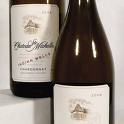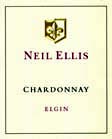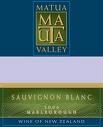Everyone seems to agree that the Stags Leap District of Napa Valley is unique because of its topography, climate and soil. The question remains whether that uniqueness translates into distinctive wines that reflect the site.
To test the theory, I spent two days in the Stags Leap District comparing the same vintage of Cabernet Sauvignon made from grapes grown in the Stags Leap District to those made from grapes grown in other California locales. … Read more

 While many California wineries are releasing their 2006 and 2007 Merlot, this 2005 is Meerlust’s current offering. As a family owned winery, Meerlust can avoid the bean counters’ focus on quarterly returns and hold the wine until they think its ready for release. …
While many California wineries are releasing their 2006 and 2007 Merlot, this 2005 is Meerlust’s current offering. As a family owned winery, Meerlust can avoid the bean counters’ focus on quarterly returns and hold the wine until they think its ready for release. …  This one, made from a blend of grapes grown in a variety of vineyards, is a step up from their basic Columbia Valley Chardonnay. It combines subtle minerality with tropical fruit flavors and buttery nuances. …
This one, made from a blend of grapes grown in a variety of vineyards, is a step up from their basic Columbia Valley Chardonnay. It combines subtle minerality with tropical fruit flavors and buttery nuances. …  Chardonnays, one from grapes grown in Stellenbosch and this one, from Elgin, South Africa’s coolest viticultural area. The cool climate is expressed by a dazzling freshness and vigor that enhances and amplifies its underlying toasty creaminess. …
Chardonnays, one from grapes grown in Stellenbosch and this one, from Elgin, South Africa’s coolest viticultural area. The cool climate is expressed by a dazzling freshness and vigor that enhances and amplifies its underlying toasty creaminess. …  In Burgundy, it’s rare to have a consistently great vintage for reds, such as 2005, or a poor one, such as 1992. In most years, there’s lots of variability. There were even duds in 2005 and some excellent 1992 reds. …
In Burgundy, it’s rare to have a consistently great vintage for reds, such as 2005, or a poor one, such as 1992. In most years, there’s lots of variability. There were even duds in 2005 and some excellent 1992 reds. …  It’s ironic that New Zealand’s signature wine, Sauvignon Blanc, usually associated with the Marlborough region on the South Island, was actually introduced into the country by Matua Valley Winery on the North Island in the 1970s. Matua has subsequently purchased vineyards in Marlborough and makes a terrific Sauvignon Blanc from grapes grown there. …
It’s ironic that New Zealand’s signature wine, Sauvignon Blanc, usually associated with the Marlborough region on the South Island, was actually introduced into the country by Matua Valley Winery on the North Island in the 1970s. Matua has subsequently purchased vineyards in Marlborough and makes a terrific Sauvignon Blanc from grapes grown there. …  The rich, almost chewy, full bodied wine has a softness with supple tannins which makes it easy to drink now. Bold, but not particularly brawny, this Shiraz emphasizes straightforward plummy black fruit flavors rather than the peppery side often characteristic of that varietal. …
The rich, almost chewy, full bodied wine has a softness with supple tannins which makes it easy to drink now. Bold, but not particularly brawny, this Shiraz emphasizes straightforward plummy black fruit flavors rather than the peppery side often characteristic of that varietal. …